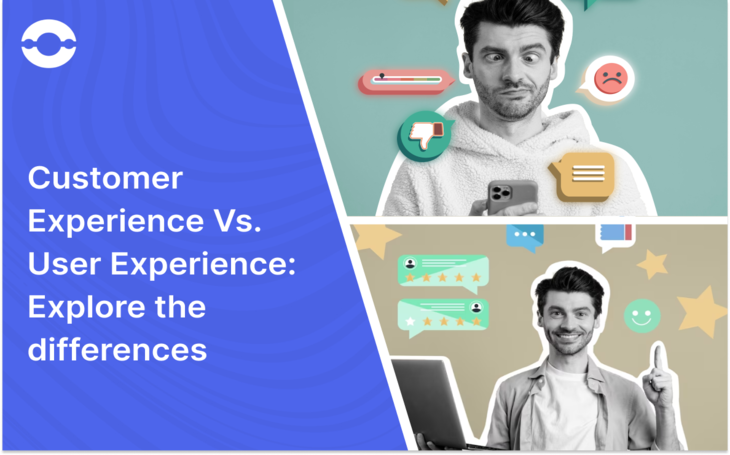
Is CX a subset of UX? Does CX have a broader scope than UX? Which one to focus on first? If such questions pop up in your head, this blog is for you.
There’s so much debate worldwide regarding which is better for a brand. CX and UX terms are used interchangeably, and both matter for a brand’s success. So, user experience and customer experience do matter a lot. At the same time, they are not equivalent.
Let’s read the blog to learn the intricacies of customer experience vs user experience.
What Is Customer Experience (CX)?
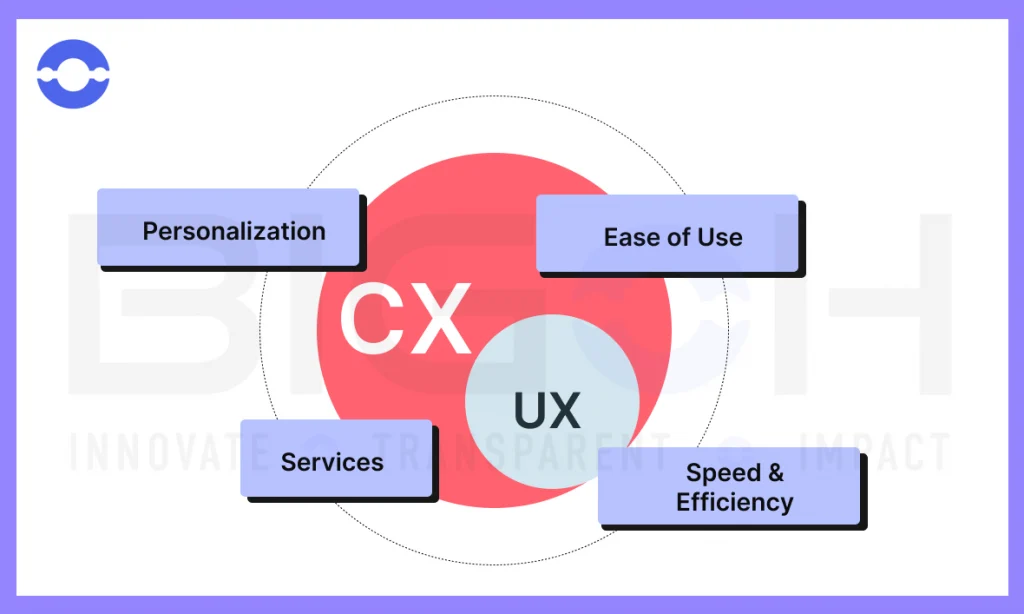
Customer experience relates to what experience customers have with your brand. It basically refers to the actions your business takes to provide superior experiences to customers.
Research studies from Forrester suggest that if businesses provide best-in-class customer experience, customers are likely to spend 4.5 times more.
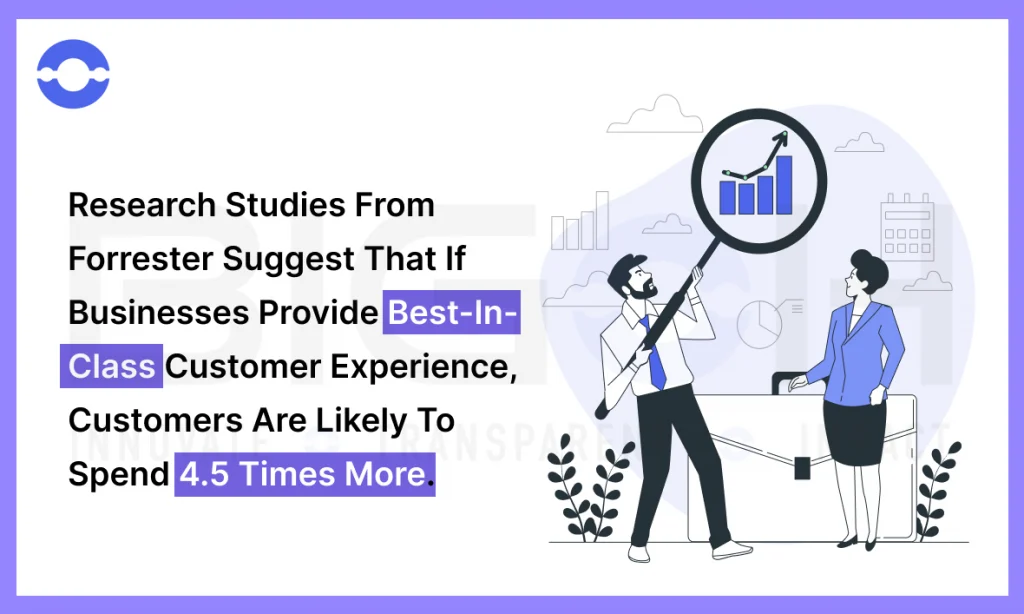
Here, customer experience is not restricted to how customers feel about your product’s usability and functionality; it covers customers’ perceptions of the organization and its products.
So, consider customer experience as the relationship customer has with the company, the interactions, touchpoints, employees, and many more. According to HubSpot integrations, CX represents the overall impression a brand has made in the mind of customers.
Regarding mobile apps, mobile apps CX matters the most than mobile app UX. Consider CX as the experience customers get when visiting across the multiple touchpoints of which an app /website is just a part.
So, all the interactions that occur right from the site, a customer identifies the brand, evaluates the purchase, makes the purchase, and finally leaves your software fall under the customer experience category.
In a nutshell, customer experience is equal to what your customers feel about your business, depending on what relationships you have built with your customer.
What Is User Experience (UX)?

UX defines the experience of the user when interacting with your product, be it your app, website, or any software. A bad UX design makes the user frustrated and confused. A brand becomes successful when the website/app has a good UX design.
The composition of UX depends on various elements such as the design of the product, usability, visual hierarchy, etc. UX means an overall experience a user gets when the product is in his/her hand till the user reaches the checkout stage.
Thus, User experience focuses on designing products that are easy and enjoyable to use and solves the end user’s problem.
If you want to provide a positive experience to customers, consider optimizing the user experience of an app or software.
You can measure the UX of an app, website, or software using the following metrics such as –
- Success rate
- Errors rate
- Clicks to completion
- Task time
- Abandonment rate
A good UX design is important because it hardly takes a few seconds for a customer to determine whether investing in apps, software, or websites is worth it.
The users would evaluate an app or a website based on various factors such as – whether it is easy to use, navigable, enjoyable, and whether it solves the user’s problem or not.
If you think that a great UX design means creating a beautiful user interface, then it’s a half-truth. A good UX designer keeps the customer at the heart of a great experience.
In a nutshell, a customer’s overall experience with your product is a UX. While CX means the experience your customers get while interacting with the brand.
Why Is UX Design Important?
A good UX design provides a positive experience to the users and lets the customers spend more time on the app/website. You are on the wrong track if you think UX won’t matter for your business.
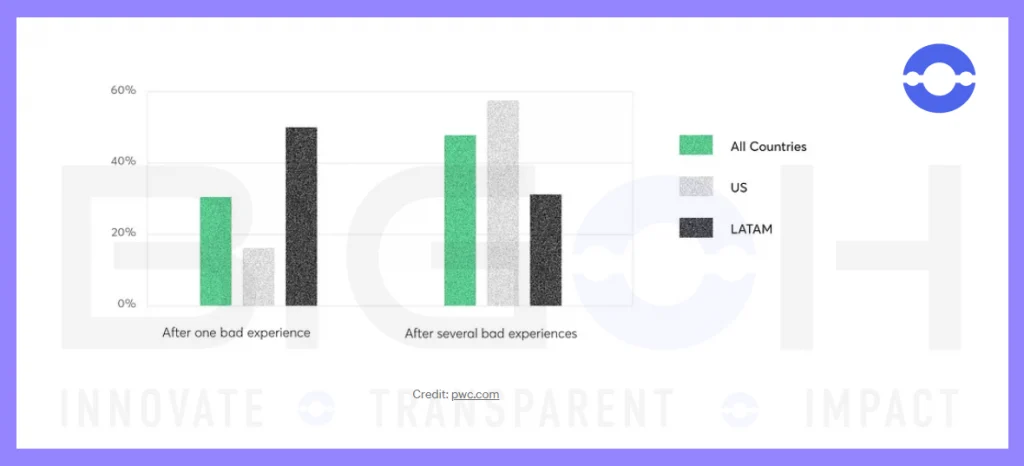
Let’s look at the following statistics that highlight the importance of UX-
- Every $1 invested in UX gives you a return of $100
- 90% of users stopped investing their time in-app because it provided poor performance
- 74% of users decide to come back to your app when it has good mobile UX
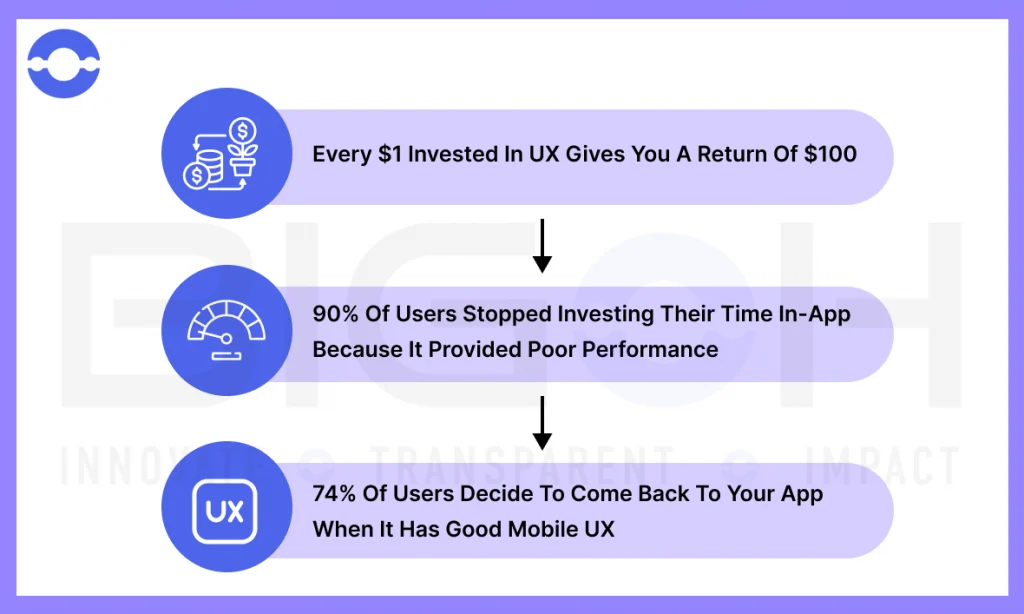
These statistics blew your mind and made you understand the importance of good UX design for your business.
So, here are a few reasons why your business needs to have good UX design-
- Having a good UX can increase conversions for your business. Moreover, overcomplicated designs of the website/ app drive the customers away from your website.
- A good UX design provides a positive experience for customers and hooks them for longer.
- Lastly, a good UX design boosts your SEO rankings.
Customer Experience vs User Experience
While Customer experience and user experience are used interchangeably, both mean differently. Customer experience has a broader scope, while UX is a subset of it.
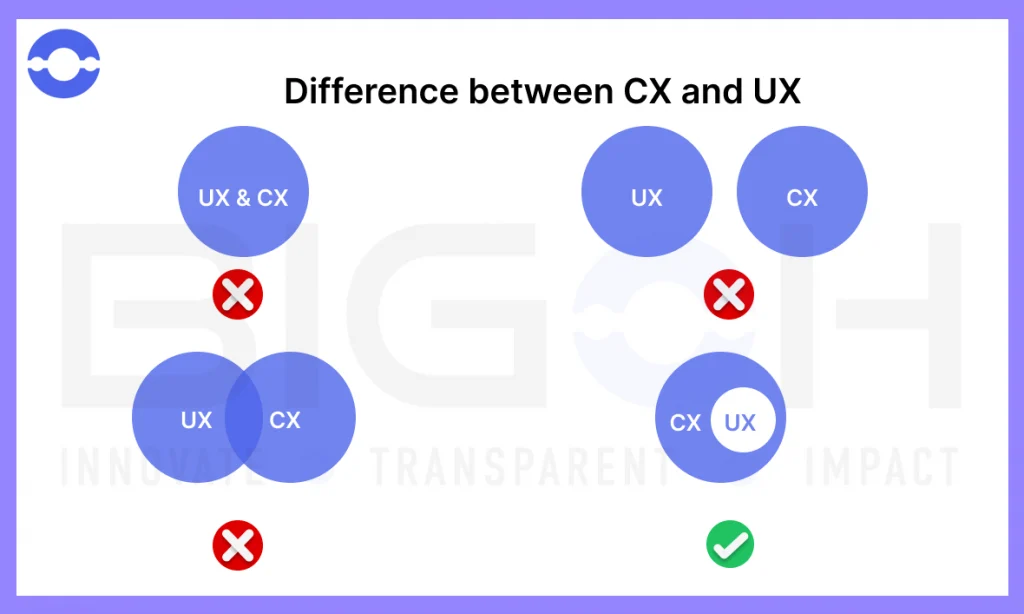
But, to give you a gist, UX means how users feel when interacting with your product. It covers various things, such as – how is the interface of an app, how easy it is to use, etc.
While customer experience means what customers feel about your brand.
Let’s walk through some of the differences between user experience vs customer experience.
1. Objectives And Goals
Undoubtedly, user experience and customer experience aim to keep the customers happy. But the goals and objectives of UX and CX differ from each other.
Steve Jobs rightly said – Start with customer experience first and then move your focus towards technology, not the other way around.
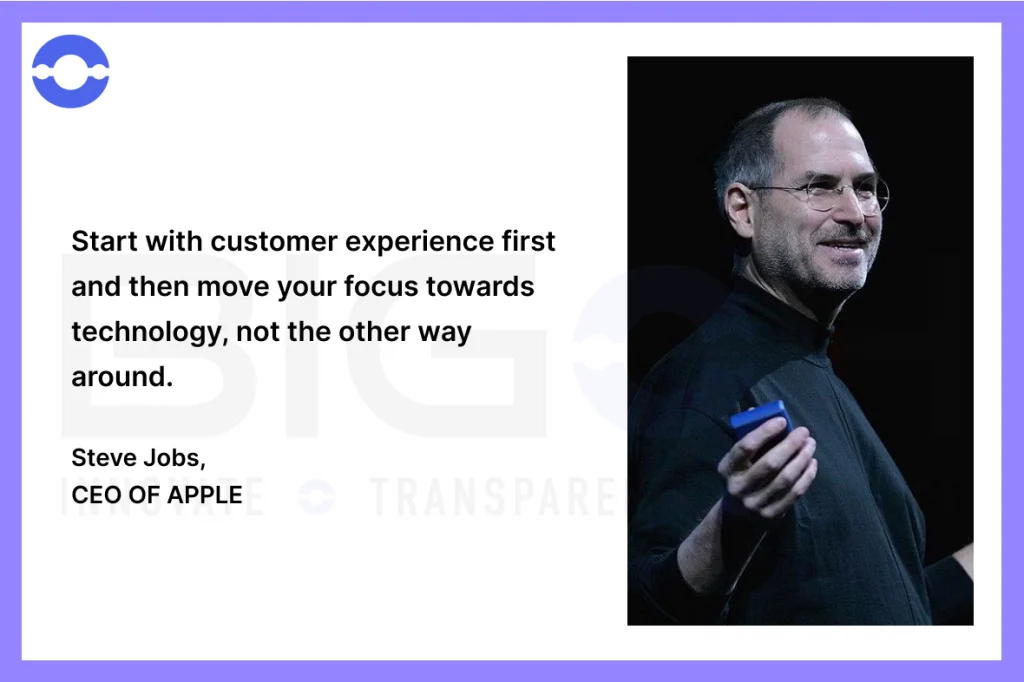
Here are the goals and objectives of CX –
- Creating a brand experience that attracts, engages, and delights customers
- Increasing customer satisfaction at every stage of the buyer’s journey
- Creating a feedback loop where customers can voice their needs
Here are the goals and objectives of UX –
- The focus is on creating a seamless product experience.
- Developing products that are easy to use, engaging, and entertaining, which in turn makes the interactions easy and accessible
- The product is there to solve customer problems.
2. Target Audience
For CX, the target audience differs. Let’s walk through how UX and CX target audience differs.
- CX Target Audience
The focus of CX strategists is to provide an overall good customer experience starting from the person researching the product to the person making the purchase. An individual or multiple people from the department represents the CX team.
- UX Target Audience
The focus of UX people is inclined toward the product’s end users (actual users), irrespective of whether they purchased it.
3. Metrics And Measurement
For CX, no one size fits all approach works. But there are multiple ways to measure customer experience.
- Customer Satisfaction
It is a popular CX metric. Based on past interactions, the customer satisfaction metric signifies how satisfied your customers are with your brand. A business can’t grow in the long term if it fails to satisfy its customers. Customer satisfaction score usually ranges between 1-5.
So, if the customer satisfaction scores represent low figures, then it means that the customer service department is not working smoothly.
For Example, share your ratings about your favorite restaurant on Google. That rating signifies customer service and the satisfaction a customer gets after availing of the service.
- Net Promoter Score
NPS represents the degree of customer loyalty regarding whether customers are likely to spread the word about your business. This score determines customer sentiments about your brand.
To calculate NPS, you can survey your customers and ask them – Give a rating of 0-10 on how likely you can recommend this service to your friend.
- Churn Rate And Retention Rate
The Churn rate represents how many customers a business loses during a specific time. While the Retention rate represents how many customers retain over a particular time frame.
- Customer Effort Score
A customer effort score metric represents how much effort a customer puts in while using the product/service. A lower CES score means that the customer is delighted.
Metrics used to measure user experience are as given below-
- Task Time
How much time does the customer take to finish a task or achieve a particular goal?
For Example, how long does it take for the user to find the contact us page on the website?
- Adoption Rate
Adoption rate refers to the ratio between new users and all the users for a product/service
- Abandonment Rate
The abandonment rate refers to the number of users who leave the task before performing an action.
For Instance – A user adds items to the shopping cart but leaves the website without purchasing. Thus, it means users abandoned the cart.
Read Also- The Importance Of UI/UX Design In IOS App Development
Why Does The Difference Matter?
Of course, the difference does matter. The concern of the UX team is inclined toward the product’s usability. While usability is not an important factor for the CX team. What matters the most for them? Providing a positive customer experience!
Thus, both are different, but implementing strategies for CX and UX makes the customers happy and satisfied. And integration of both these elements (UX & CX) defines how customers feel about you and your products.

How Can BigOh Help?
We care about businesses that want to expand their horizon and get incremental results in the long term. At BigOhTech, we provide UI/UX design services to help startups and enterprises like yours with aesthetically appealing, easy-to-navigate, and user-friendly interfaces.
We offer various solutions in one box, starting with UX research, UX design, UI design, branding, and identity, and conducting usability testing.
Our UX designers have 9+ years of experience creating smooth, easy-to-navigate user interfaces that bring remarkable results for your business, such as a higher conversion rate and increased brand visibility.
Conclusion
Now, you get to know about the topic – customer experience vs user experience. In this digital world, it’s becoming difficult for brands to stand out, and providing a better customer experience matters the most.
UX designers are concerned about designing a better product, while CX strategists focus on improving the customer experience.
As both factors are crucial for brand success, the business should use both to make the customers feel good about the brand and the product.
Have any questions with respect to UX/CX? Head over to the contact us section of our website, and our experts will guide you through the journey.
FAQs
UX and CX are interconnected because CX is a broad term, and UX is just a part of CX. UX plays a vital role in every part of the customer’s journey because customers need a smooth and easy-to-use interface to have good perceptions of the brand.
So, UX and CX teams should work in a loop to improve customer experience.
There are 3 major categories of UX design:
1. Interaction design
2. Visual design
3. Information Architecture
UX differs from CX depending on various factors – target audience, metrics, and objectives.
For Instance – The target audience of the UX strategist is the end user (the actual user of the product/service). In contrast, the target audience of the CX strategist is the customer who purchases the product. It does not matter whether the customer is an end user or not.
The customer experience (CX) is important for a business because of the following reasons-
1. It provides maximum satisfaction to the customers
2. It improves the retention rate of a business
3. Good quality customer service reduces the churn rate for business
User experience (UX) is important for a business because of the following reasons-
1. A good UX design increases conversions for your business
2. It brings higher revenue for the business
3. A fast-loading website/mobile app boosts user engagement
Here are a few things to improve CX-
1. Use the latest technologies like AI and chatbots to provide a seamless experience to customers
2. Voice your customer opinion. Ensure taking regular feedback from customers
3. Conduct an audit of customer experience from multiple departments
Here are a few things to improve UX-
1. Conduct user research
2. Keep the design simple yet minimalistic
3. Take customer feedback throughout the design process




